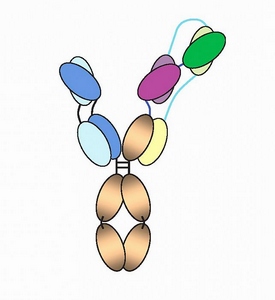Three-in-one antibody protects monkeys from HIV-like virus
NIH and Sanofi scientists prepare to test antibody in people.
A three-pronged antibody made in the laboratory protected monkeys from infection with two strains of SHIV, a monkey form of HIV, better than individual natural antibodies from which the engineered antibody is derived, researchers report in Science on September 20.

Diagram of the “three-in-one” HIV antibody. The blue, purple and green segments each bind to a different critical site on the virus.
The three-pronged antibody, created by investigators from the National Institutes of Health (NIH) and the Paris-based pharmaceutical company Sanofi, also stopped a greater number of HIV strains from infecting cells in the laboratory more potently than natural, single antibodies. This new broadly neutralizing antibody binds to three different critical sites on HIV.
Plans are under way to conduct early-phase clinical trials of the “trispecific” antibody in healthy people and in people living with HIV in the hope that it could eventually be used for long-acting HIV prevention and treatment. By binding to three different sites on the virus, the new antibody should be harder for HIV to dodge than natural, single antibodies.
“Combinations of antibodies that each bind to a distinct site on HIV may best overcome the defenses of the virus in the effort to achieve effective antibody-based treatment and prevention,” said Anthony S. Fauci, M.D., director of the National Institute of Allergy and Infectious Diseases, part of NIH. “The concept of having a single antibody that binds to three unique sites on HIV is certainly an intriguing approach for investigators to pursue.”
The trispecific antibody reported on September 20, was created and tested through a collaborative research and development agreement between NIAID and Sanofi under the leadership of John R. Mascola, M.D., director of the NIAID Vaccine Research Center (VRC), and Sanofi Chief Scientific Officer and Senior Vice President Gary J. Nabel, M.D., Ph.D. The three HIV-binding segments of the antibody are based on three individual HIV antibodies, each of which powerfully neutralizes many strains of the virus. Scientists at NIAID and the IAVI Neutralizing Antibody Consortium of The Scripps Research Institute in La Jolla, California, previously isolated these individual antibodies from people living with HIV.
Researchers at the VRC and Sanofi tested dozens of bispecific and trispecific antibodies in the laboratory to find the best-performing combination. Individual antibodies were combined into trispecific antibodies using technology proprietary to Sanofi. The most successful formula combines the unique structures of the broadly neutralizing HIV antibodies called VRC01, PGDM1400, and 10E8v4.
VRC scientists tested this trispecific antibody in an experiment involving monkeys and two strains of SHIV. One SHIV strain is sensitive to neutralization by VRC01 and the trispecific antibody, but resistant to neutralization by PGDM1400. The other SHIV strain is sensitive to neutralization by PGDM1400 and the trispecific antibody, but resistant to neutralization by VRC01. Scientists from the Center for Virology and Vaccine Research at Beth Israel Deaconess Medical Center in Boston provided these SHIV strains.
The VRC researchers gave infusions of VRC01 to eight monkeys, PGDM1400 to another eight monkeys, and the trispecific antibody to a third group of eight monkeys. Five days later, the scientists exposed all 24 monkeys to both SHIV strains. Five of the eight monkeys that received PGDM1400 and six of the eight monkeys that received VRC01 became infected with SHIV, but none of the monkeys that received the trispecific antibody became infected.
Sanofi is manufacturing the trispecific antibody for use in a Phase 1 clinical trial that will be conducted by NIAID to test the antibody’s safety and pharmacokinetics in healthy people beginning in late 2018. Discussions also are under way with the NIAID-funded AIDS Clinical Trials Group to conduct a separate Phase 1 clinical trial of the antibody in people living with HIV.
“The partnership between NIAID and Sanofi has been invaluable and allows us to move this trispecific antibody from the lab and preclinical testing into the clinic,” said Dr. Mascola.
The ability of trispecific antibodies to bind to three independent targets at once could make them a useful prototype for treatments developed not only for HIV but also for other infectious diseases, autoimmune diseases and cancers, according to the study authors.
Source: U.S. National Institutes of Health
- 327 reads
Human Rights
Ringing FOWPAL’s Peace Bell for the World:Nobel Peace Prize Laureates’ Visions and Actions

Protecting the World’s Cultural Diversity for a Sustainable Future

The Peace Bell Resonates at the 27th Eurasian Economic Summit

Declaration of World Day of the Power of Hope Endorsed by People in 158 Nations

Puppet Show I International Friendship Day 2020

